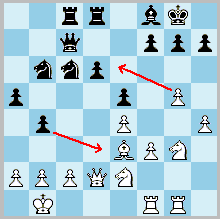
Knight pawns on the fifth rank have an additional jump move to empty square. The extra capability of the advanced knight pawn reinforces an attacking strategy.

Knight pawns on the fifth rank have an additional jump move to empty square. The extra capability of the advanced knight pawn reinforces an attacking strategy.
In Valiant Chess (also V-chess) the knight pawn, having advanced to the fifth rank, can jump like a knight to an empty square, east-north-east or west-north-west. Only knight pawns on the fifth rank have this capability. The pawn loses this capability when it advances to the 6th rank. Compared with standard chess, this means that an advanced knight pawn is endowed with an extra jump move. Valiant Chess is specially designed for rapid chess, since it makes the game more aggressive and less monotonous. Aggressive play on the flanks is facilitated as the Valiant pawn makes it possible to pry open the pawn chain, something which greatly enhances attacking play. In this way one can open the file in order to attack the king, or disrupt the position for attacking purposes. This new rule favours the advance of the knight pawn, which leads to a more aggressive game.
In an alternative variant both the knight- and rook pawn, having advanced to the fifth rank, can make this knight jump to empty square. This could lead to wild play. The most conservative variant is to allow the jump only when the pawn is blocked (see diagram below). These variants have been implemented in my Zillions program.
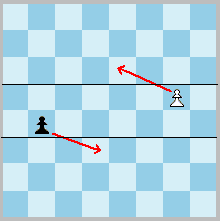 The knight pawn, if placed on the fifth rank, can make the oblique jump move to an empty square. There are no other requirements to make this move. In an alternative variant, also the rook pawn (or any pawn) has this capability. Curiously, the fifth rank is already special in that it is the 'en passant' rank.
The knight pawn, if placed on the fifth rank, can make the oblique jump move to an empty square. There are no other requirements to make this move. In an alternative variant, also the rook pawn (or any pawn) has this capability. Curiously, the fifth rank is already special in that it is the 'en passant' rank.
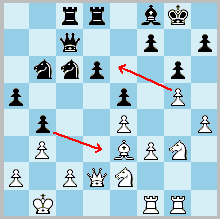 In an alternative variant, the knight pawn can only make the jump move if blocked by an enemy pawn on the 6th rank. Since its way is blocked, it can take another route. Alternatively, this rule is valid also for the rook pawn.
In an alternative variant, the knight pawn can only make the jump move if blocked by an enemy pawn on the 6th rank. Since its way is blocked, it can take another route. Alternatively, this rule is valid also for the rook pawn.
In the general case, it is easy to control these extra destination squares, or to occupy them, thus preventing the pawn from going there. In many cases it is simply bad to go there. However, it opens up many new attacking possibilities. This pawn move isn't illogical. It moves forward one rank, which is natural to the pawn. Keep in mind that the pawn is already different from all other pieces in that it can only advance to an empty square, different from the capture square. In this variant, yet another pawn advance to empty square is added, provided that the pawn is positioned at the knight file and the fifth rank. It is a natural move that already belongs in chess in the form of the knight jump. Interestingly, there is a corresponding rule in Xiangqi (Chinese Chess). When the pawn passes the middle line it acquires the capacity to move sideways. See also Dynamic Chess and Improved Chess.
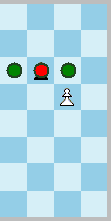 The extra pawn move is natural. In chess, there are three types of moves: (1) diagonal, (2) orthogonal, (3) oblique (knight jump). Comparatively, in Xiangqi the horse-move is orthogonal and then diagonal, which is why the horse can be blocked. So Xiangqi has only the diagonal and orthogonal moves. The chess pawn already has the orthogonal and diagonal movement, to which I am adding the oblique movement. The pawn can still only advance to the next rank, by way of a diagonal, orthogonal, or oblique move. So the Valiant pawn can now perform all types of chess moves, one step forwards.
The extra pawn move is natural. In chess, there are three types of moves: (1) diagonal, (2) orthogonal, (3) oblique (knight jump). Comparatively, in Xiangqi the horse-move is orthogonal and then diagonal, which is why the horse can be blocked. So Xiangqi has only the diagonal and orthogonal moves. The chess pawn already has the orthogonal and diagonal movement, to which I am adding the oblique movement. The pawn can still only advance to the next rank, by way of a diagonal, orthogonal, or oblique move. So the Valiant pawn can now perform all types of chess moves, one step forwards.
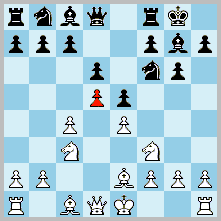 An interesting question is whether it's possible to allow the extra jump move with all pawns at the fifth rank? This is the Petrosian system in the King's Indian, which is regarded as equal. Would the immediate pawn push to d5 render a small advantage for White if it is a Valiant pawn? It would make this variant theoretically fashionable again. This variant is also implemented.
An interesting question is whether it's possible to allow the extra jump move with all pawns at the fifth rank? This is the Petrosian system in the King's Indian, which is regarded as equal. Would the immediate pawn push to d5 render a small advantage for White if it is a Valiant pawn? It would make this variant theoretically fashionable again. This variant is also implemented.
Discussion
Rapid chess on Internet servers isn't very engaging in the long run, because chess isn't designed to be played at this rapid pace. With Xiangqi it works very fine, however. One is always presented with tactical problems, from the first to the last move. There is no monotonous wood-chopping, so it's suitable for rapid play. Rapid chess would be much more fun if the tactical vistas were to be opened up, although slow standard chess at amateur level is a different matter. In this Chessbase article series "Give up the sissy version - play Chinese chess!" prof. David H. Li expounds on his love of Xiangqi (here).
Don't let yourself be fooled, chess is the superior game. The difference is that Xiangqi is never boring, because there are always clever little tactics, sometimes involving the cannon. Cannon tactics, unknown to Western chess players, is very peculiar. The conclusion is that Xiangqi is more rewarding when played over the Internet, with the exception of blitz and bullet games, which involve a race against the clock. Chess in this form is exciting but not very sophisticated.
Chess involves many standard methods, like realizing a passed pawn on a wing, thereby forcing the enemy king to hunt it down, whereupon you can enter his position, capture his pawns, advance your own pawn and promote to queen. Such methods don't exist in Xiangqi. You always have to figure out how to mate the other party before he mates you, with whatever little material there is left. Pawns don't promote.
Chess, when played rapidly, always boils down to standard methods of tactics, standard piece exchanges, standard mating methods, standard positional plans (taking control of an open file with the heavy pieces is a theme repeated over and over again). It is a matter of technique and opening knowledge. I admit that rapid chess is slightly fun, but Xiangqi is much more exciting when played over the Internet, because one cannot apply monotonous standard techniques. A player who tries, will lose immediately. You always have to be on your guard.
Chess is deep and must be played deeply. However, since chess is so extremely methodical, it also lends itself to blitz and bullet games. It occupies the extremes, that is. Xiangqi is not suited for blitz and bullet games, unless you are extremely skilled. There are too many exacting moves to be done. Too a high-degree chess can be played with the auto-pilot switched on. This is not possible with Xiangqi. But when chess is played with the auto-pilot you soon get tired of the wood-chopping, although there is a nice combination now and then.
Compared with chess, Xiangqi and Shogi overflow with tactics, which is why these games are never boring and monotonous. I am arguing that we are doing chess a disservice when we refuse to provide chess players with an alternative variant in which they can get an outlet for their creativity and tactical imagination. It would function as a complement to Fide-chess, and would serve to enrich chess, in order for it to remain popular.
☛ You can download my free Valiant Chess program here (updated 2012-05-24), but you must own the software Zillions of Games to be able to run it (I recommend the download version).
☛ You can play Valiant Chess online and by e-mail here.
☛ Don't miss my other chess variants.
Zusammenfassung
Der Springerbauer (b, g) bekommt einen extra Springer zug nach leeren Feld, was löst das Blockade Problem! Mit dieser Regel wird das Spiel weniger strategisch, noch taktischer. Die Blockade der Flankebauern ist ein sehr feines Thema, aber nicht im Schnellschach. Wir verändern die Regel ein bisschen, und Schnellschach ist wieder intellektuell anregend. Dieses Bauernsprung ist gut. Der Gegner kann es verhindern, weil Er kann das Feld Bezetsen. So es ist nicht immer einfach zu erreichen. Die Spieler haben immer noch die Kontrolle. In einer alternativen Variante, auch der Turmbauer kann diesen Schritt machen. Beachten Sie, dass Mein Vorschlag behält den blockierten Bauernkette, sonst wäre es nicht mehr Schach genannt werden.
Dieser Schritt ist natürlich. Im Schach gibt es drei Arten von Bewegungen: (1) diagonal, (2) orthogonal, (3) 'oblique'. Letzteres ist der Springerzug. Zum Vergleich: In Xiangqi das Pferd-Zug ist orthogonal und dann diagonal, warum das Pferd-Bewegung blockiert werden kann. So Xiangqi hat nur die diagonale und orthogonale Bewegungen. Der Schachbauer hat bereits die orthogonale und diagonale Bewegungen. Ich füge die oblique Bewegung. Der Bauer kann nur auf die nächste Reihe vorrücken. Dies wird durch eine diagonale, orthogonale oder oblique Zug durchgeführt. Also der Bauer kann nun alle Arten von Bewegungen machen, ein Schritt nach vorn.
© M. Winther, 2012 April